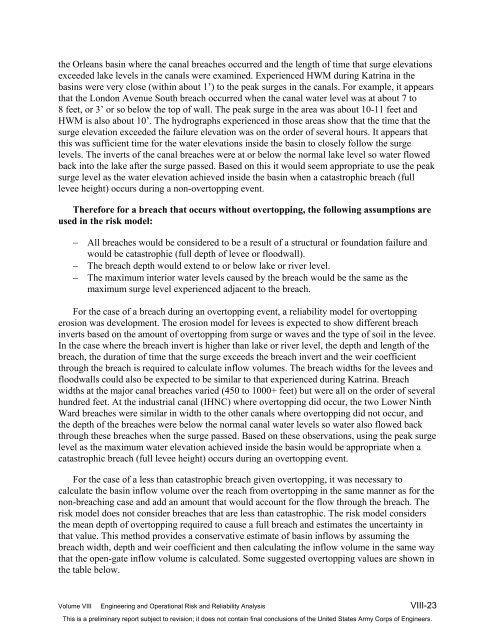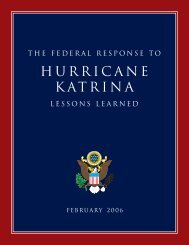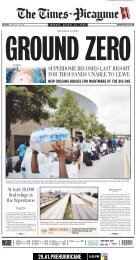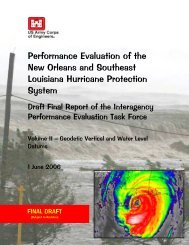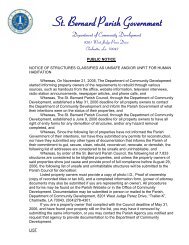IPET Report 3 Vol VIII
IPET Report 3 Vol VIII
IPET Report 3 Vol VIII
Create successful ePaper yourself
Turn your PDF publications into a flip-book with our unique Google optimized e-Paper software.
the Orleans basin where the canal breaches occurred and the length of time that surge elevations<br />
exceeded lake levels in the canals were examined. Experienced HWM during Katrina in the<br />
basins were very close (within about 1’) to the peak surges in the canals. For example, it appears<br />
that the London Avenue South breach occurred when the canal water level was at about 7 to<br />
8 feet, or 3’ or so below the top of wall. The peak surge in the area was about 10-11 feet and<br />
HWM is also about 10’. The hydrographs experienced in those areas show that the time that the<br />
surge elevation exceeded the failure elevation was on the order of several hours. It appears that<br />
this was sufficient time for the water elevations inside the basin to closely follow the surge<br />
levels. The inverts of the canal breaches were at or below the normal lake level so water flowed<br />
back into the lake after the surge passed. Based on this it would seem appropriate to use the peak<br />
surge level as the water elevation achieved inside the basin when a catastrophic breach (full<br />
levee height) occurs during a non-overtopping event.<br />
Therefore for a breach that occurs without overtopping, the following assumptions are<br />
used in the risk model:<br />
− All breaches would be considered to be a result of a structural or foundation failure and<br />
would be catastrophic (full depth of levee or floodwall).<br />
− The breach depth would extend to or below lake or river level.<br />
− The maximum interior water levels caused by the breach would be the same as the<br />
maximum surge level experienced adjacent to the breach.<br />
For the case of a breach during an overtopping event, a reliability model for overtopping<br />
erosion was development. The erosion model for levees is expected to show different breach<br />
inverts based on the amount of overtopping from surge or waves and the type of soil in the levee.<br />
In the case where the breach invert is higher than lake or river level, the depth and length of the<br />
breach, the duration of time that the surge exceeds the breach invert and the weir coefficient<br />
through the breach is required to calculate inflow volumes. The breach widths for the levees and<br />
floodwalls could also be expected to be similar to that experienced during Katrina. Breach<br />
widths at the major canal breaches varied (450 to 1000+ feet) but were all on the order of several<br />
hundred feet. At the industrial canal (IHNC) where overtopping did occur, the two Lower Ninth<br />
Ward breaches were similar in width to the other canals where overtopping did not occur, and<br />
the depth of the breaches were below the normal canal water levels so water also flowed back<br />
through these breaches when the surge passed. Based on these observations, using the peak surge<br />
level as the maximum water elevation achieved inside the basin would be appropriate when a<br />
catastrophic breach (full levee height) occurs during an overtopping event.<br />
For the case of a less than catastrophic breach given overtopping, it was necessary to<br />
calculate the basin inflow volume over the reach from overtopping in the same manner as for the<br />
non-breaching case and add an amount that would account for the flow through the breach. The<br />
risk model does not consider breaches that are less than catastrophic. The risk model considers<br />
the mean depth of overtopping required to cause a full breach and estimates the uncertainty in<br />
that value. This method provides a conservative estimate of basin inflows by assuming the<br />
breach width, depth and weir coefficient and then calculating the inflow volume in the same way<br />
that the open-gate inflow volume is calculated. Some suggested overtopping values are shown in<br />
the table below.<br />
<strong>Vol</strong>ume <strong>VIII</strong> Engineering and Operational Risk and Reliability Analysis <strong>VIII</strong>-23<br />
This is a preliminary report subject to revision; it does not contain final conclusions of the United States Army Corps of Engineers.


